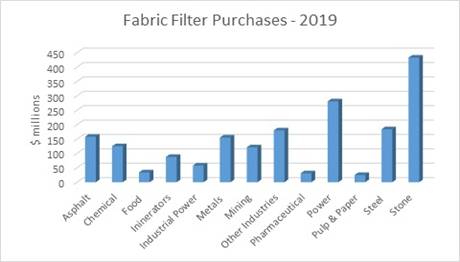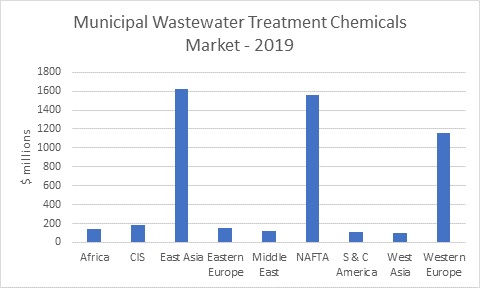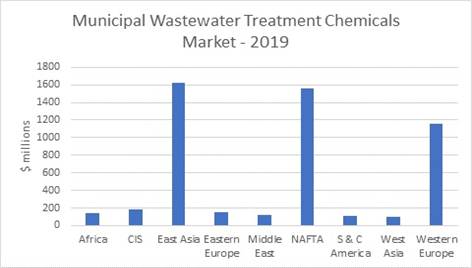
WELCOME
Weekly selected highlights in flow control, treatment and combustion from the
many McIlvaine publications.
The Changing Market for Gas Turbine Combust, Flow and Treat Products and
Services
Sales of combust, flow and treat products and services for gas turbine power
plants will exceed $80 billion this year. This is the latest forecast in
59EI Gas Turbine and Reciprocating Engine Supplier Program.
This forecast does not include the gas turbines, steam turbines or HRSGS but
does include all the valves, pumps, piping, filters, emission control and other
products. It includes the
instrumentation and the process management software.
It includes the repair and replacement of all these components as well.
It includes consumables such as inlet air filters and water treatment chemicals,
GTCC plant owners will spend $ 1.4 billion this year just for corrosion and
scale inhibitors.
The details on this market are covered in a McIlvaine YouTube analysis
https://youtu.be/OBeeTfWgb9A
Third party operation is expanding and will accelerate the adoption of IIoT and
Remote O&M. Large plant suppliers such
as MHPS and Doosan are moving into remote monitoring and operational support.
ITOCHU/NAES is now operating hundreds of plants.
CFT suppliers should be out in front leading the march into the post digital age
and selling a wisdom based program to their customers. In the McIlvaine
59EI
Gas Turbine and Reciprocating Engine Supplier Program
there is a recommended approach to identifying each prospect. For each
product the supplier can prepare a lowest total cost ownership validation
(LTCOV). This is accomplished with collaboration and a combination of Wisdom
tools which not only present the LTCO but validate it (LTCOV) by connecting with
the individual purchasers. This is
the route to higher sales.

In the post digital age with experts analyzing an avalanche of data it will be
possible to determine the total cost of ownership for each product. The supplier
can determine where he can validate the lowest total cost of ownership on a Tier
1 basis. Tier 1 is a general validation for most applications.
In making a presentation to a specific customer the supplier should offer
a Tier 2 LTCOV which takes into account variables such as local regulations and
electricity cost differences between plants.
The LTCOV to be credible has to be backed up with papers and analyses most of
which are already available but need to be made accessible.
The LTCOV needs to be the product of decision systems with subject matter
ultra-expert input. The Validation
is a continuing process based on changing competitor offerings and industry
developments which can be determined and analyzed through wise crowd decisions.

59EI Gas Turbine and Reciprocating Engine Supplier Program
provides details on 20,000 GT plants and
a program to determine the total available market and the basis for determining
the Serviceable Obtainable Market and the Wisdom based Obtainable Market which
includes the knowledge support and remote monitoring.
There is sufficient detail on each plant to determine the Tier 2 LTOCV factors.
McIlvaine can provide assistance to continually update the right to win
analysis.

Bob McIlvaine is available to conduct a GoToMeeting on the report and program.
Arrangements can be made by contacting him at
rmcilvaine@mcilvainecompany.com
847-784-0012 ext. 122, mobile 847-226-2391.
2018 Will be Another Good Year for the Cleanroom Industry
The cleanroom industry is on an expansion track.
Sales of hardware will exceed $5.5 billion. Purchases of cleanroom
consumables will top $8.5 billion. This is the latest forecast in the
continually updated
N6F World Cleanroom Markets.
The semiconductor segment remains the largest purchaser. Semiconductor equipment
sales are anticipated to rise 11 percent this year whereas shipments will
increase over 20 percent.
The growth of the cleanroom industry in Asia will exceed other areas. China
alone will spend more on electronics cleanrooms than Europe and Japan combined.
This is in part due to the fab lite strategy of semiconductor suppliers in those
areas. Japanese semiconductor
companies are content to rely on foundries being built in China and elsewhere.
Cleanroom expenditures for manufacture of components used in cleanrooms are also
expanding. Examples would be new
cleanrooms for a manufacturer of high purity hose and tubing and one for a
supplier of cleanroom lifting machinery.
The applications for cleanrooms are also expanding. This includes custom
preparation of tailored chemotherapy infusions and cell therapy treatments in
hospitals and metal powders for 3D printing.
Both the semiconductor and pharmaceutical industry are characterized by
consolidation. The top three
pharmaceutical manufacturers will purchase more than 10 percent of the cleanroom
consumables purchased by the industry.
|
Purchases of Cleanroom
Consumables by Pharmaceutical
Manufacturers |
||||
|
Rank |
Company |
Gloves |
Wipes |
Disposable Clothing |
|
1 |
Pfizer |
7.70 |
4.66 |
8.36 |
|
2 |
Roche |
5.76 |
3.49 |
6.25 |
|
3 |
Merck |
5.25 |
3.18 |
5.70 |
For more information on the report click on
N6F World Cleanroom Markets